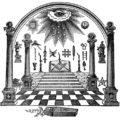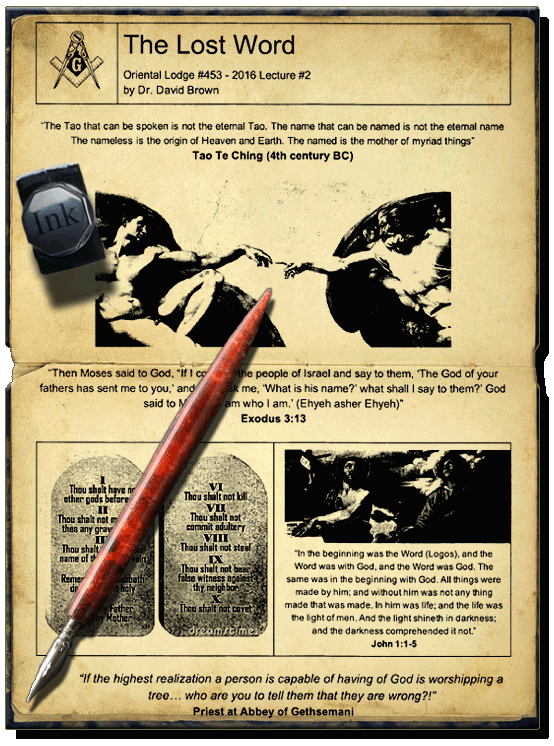
“The Tao that can be spoken is not the eternal Tao.
The name that can be named is not the eternal name
The nameless is the origin of Heaven and Earth.
The named is the mother of myriad things”
Tao Te Ching (4th century BC)
Masonry contains rituals that speak of lost words…. passwords or in some cases explicit references that say that what was lost was the name or the true pronunciation of the name of God. There are sometimes substitute names or a more comprehensive name given as an initiate progresses through grades in the Scottish Rite.
What is meant when we say that the true name of God has been forgotten or that the pronunciation of the true name has been forgotten?
The Bible says that man and God were once on a first name basis. In fact, God would walk with man in the Garden of Eden in the cool of the evening. But man became alienated from God when he ate from the fruit of the Knowledge of Good and Evil. Before this, man was at one with God, not knowing himself to be separate, not even knowing he was naked or even that he existed. 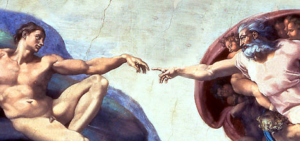
Figure 1 – The Creation of Man (Michelangelo)
Eden represents the timeless time before self-consciousness. The Knowledge of Good and Evil is the birth of self-consciousness and its associated knowledge of separateness from others and from God (before this we didn’t realize we were different) and also an internal alienation from our own physicality.
We can symbolize this alienation of losing our personal relationship to God as forgetting how to call on Him, of forgetting his name.
The Old Testament later describes how the Israelites wandered for 40 years in the desert, losing their faith and regaining when Moses ascends Mt. Sinai and God reveals his name:
“Then Moses said to God, “If I come to the people of Israel and say to them, ‘The God of your fathers has sent me to you,’ and they ask me, ‘What is his name?’ what shall I say to them?” God said to Moses, “I am who I am.” (Ehyeh) And he said, “Say this to the people of Israel, ‘I am has sent me to you.’” God also said to Moses, “Say this to the people of Israel, ‘The Lord, the God of your fathers, the God of Abraham, the God of Isaac, and the God of Jacob, has sent me to you’: this is my name for ever, and thus I am to be remembered throughout all generations.”
Exodus 3:13-15
Moses returns from Mt. Sinai with God’s Law – The 10 Commandments, the first three of which pertain to the name of God and how to (or not to) symbolize God.
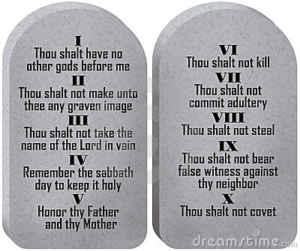
Figure 2 – The Ten Commandments
The first commandment “Thou shalt have no other gods before me.” says that there is only one ultimate reality. There is also the implication that if there are any other gods, they are “after” or merely aspects of the One.
The second commandment “Thou shalt not make unto thee any graven image.” says that the ultimate reality should not be equated to a symbol. There is no symbol for the ultimate reality.
The third commandment “Thou shalt not take the name of the Lord thy God in vain.” says that the name of God (the symbol we use for God) should be reverenced. The Hebrew tradition substitutes “Adonia” (“my Lords”) for the name of God (YHVH) to reinforce their reverence for the Tetragrammaton (“four-lettered name”).
Later in the Old Testament, the prophets foretold of the coming of a Messiah who would set things right again and allow us to once again have a personal relationship with God. Solomon’s Temple is built as a house for the Word to come alive.
The New Testament then describes how Jesus becomes the “Living Word” and the intermediary between God and Man providing us with new symbols (Christ’s temptation and passion, the cross, the tomb, resurrection, etc.).
One of the patron saints of Masonry speaks of this Word in John 1:1-5:
“In the beginning was the Word (Logos), and the Word was with God, and the Word was God. The same was in the beginning with God. All things were made by him; and without him was not any thing made that was made. In him was life; and the life was the light of men. And the light shineth in darkness; and the darkness comprehended it not.”
John 1:1-5
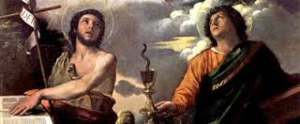
Figure 3 – The Saints John
Jesus is alive in our hearts and living through us. This is the Christian revelation, but this is not the only way to think about, approach or have a personal relationship to God.
Masonry understands this as It requires a belief in God, but does not require it to be a specific image of God. Every image of God is in some sense an “idol” and is both our means of having a relationship to God and our biggest barrier to a personal relationship as well.
God is unity. Complete unity. God is not necessarily a person sitting on a throne looking down on us. God is how we as “mere mortals” attempt to make sense of infinity from our extremely limited perspective. Some people imagine God as a person. Some people imagine God as possessing animal powers. Some people see God in the forces of nature. Some people see God as abstract forces or as mathematical formulas.
I see God as a programmer, but that is only because I am a programmer and that is the highest form of God that I can really imagine: God as the ultimate programmer who programmed the rules of physics and evolution into His/Her creation and we watch and experience this program unfolding in time.
A few years ago I spent some time at the Abbey of Gethsemani, a Trappist monastery in Bardstown, Kentucky. The monks there take a vow of silence and only speak rarely. I happened to be there on Easter Sunday and heard a sermon by one of these monks. He sounded like a New Yorker, but for certain he was a “Yankee.” He started his sermon by seemingly mocking a southern drawl, moving around and waving his hands yelling “Praise Jesus! Hallelujah! Praise the Lord!”
Everyone in the chapel froze and you could feel the tension in the air. The monk went on to seemingly denigrate many other religious practices and expressions, but as the sermon progressed the message coalesced into one of tolerance and understanding. The punchline was that we all are seeking God in our own particular way, which may be different from the others around us:
“If the highest realization a person is capable of having of God is worshipping a tree… who are you to tell them that they are wrong?!”
Priest at Abbey of Gethsemani (Bardsville, KY)
How we symbolize God tells more about who we are than about what God is. There is only one God and His name is not YHVH or Allah or Shiva or any other name. Each of these names reveals an aspect of divinity, but they are only substitute names because ultimate reality has no name.
As Masons we will keep looking for this “Lost Word” and also helping others to find it within themselves – no matter how they choose to symbolize it. Within Masory and the Scottish Rite there is a rich tradition around God’s name, the loss of it, finding substitute names and ultimately finding new and more expressive ways to think about and approach God.
For the Word to truly live it must come alive in that temple not made with hands, your own heart.


